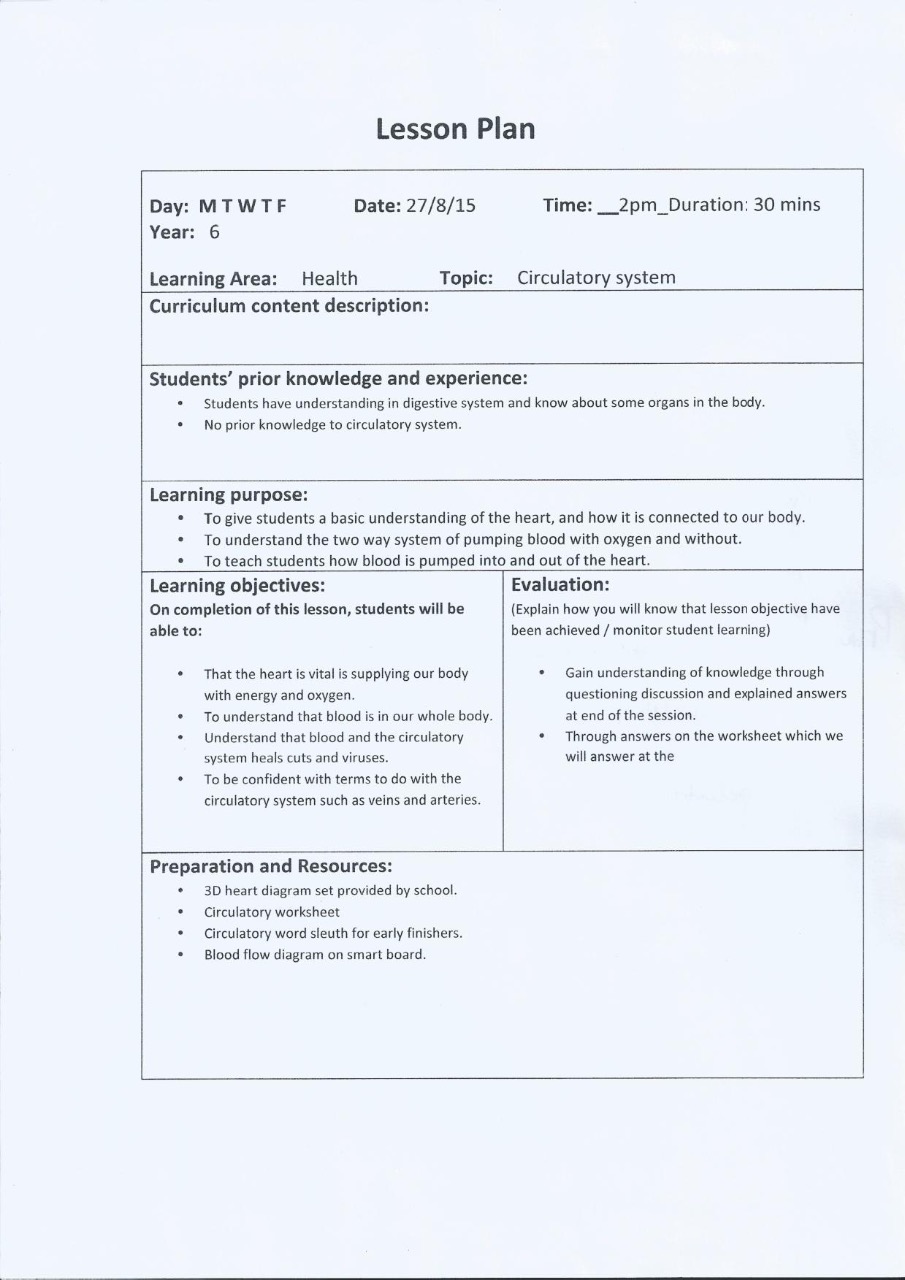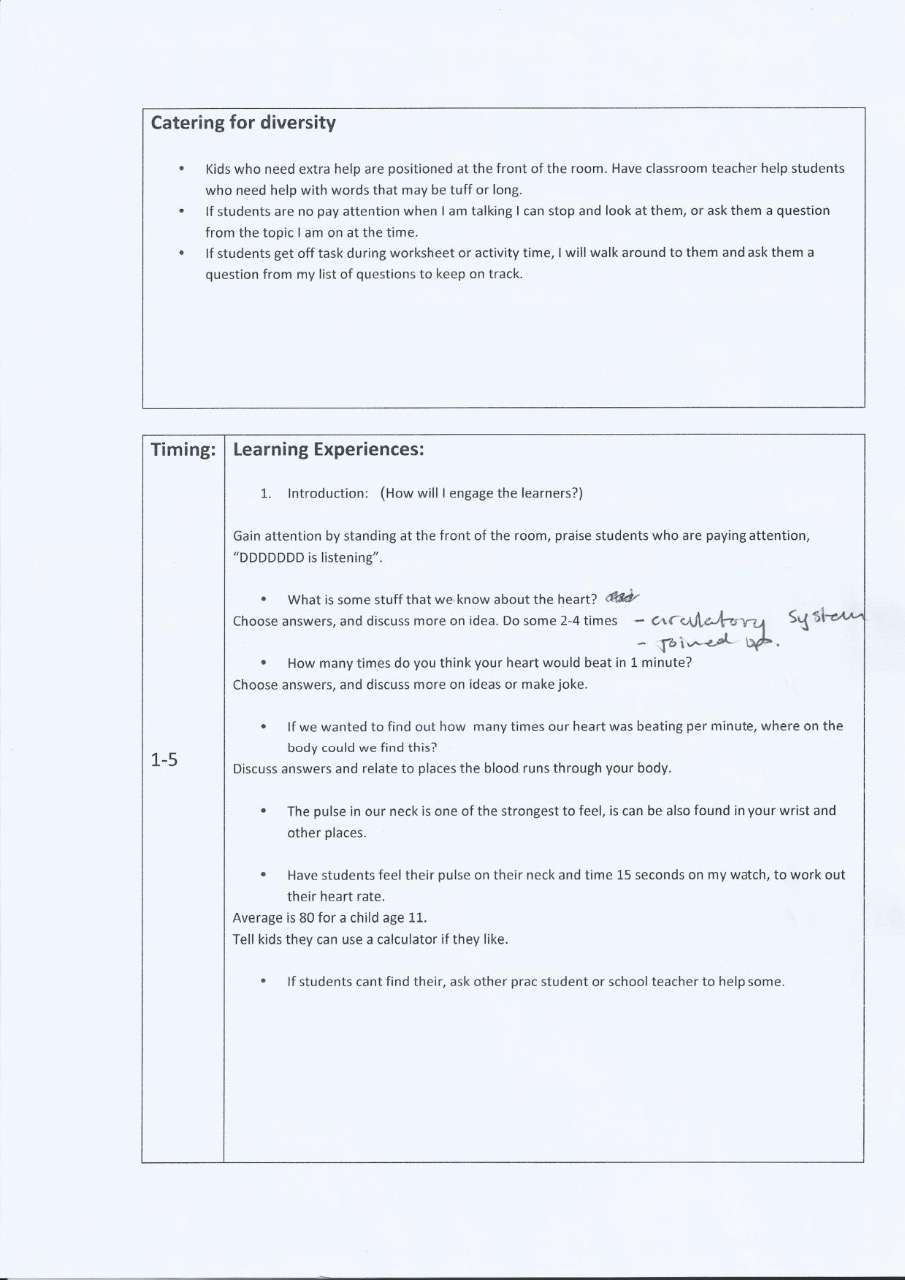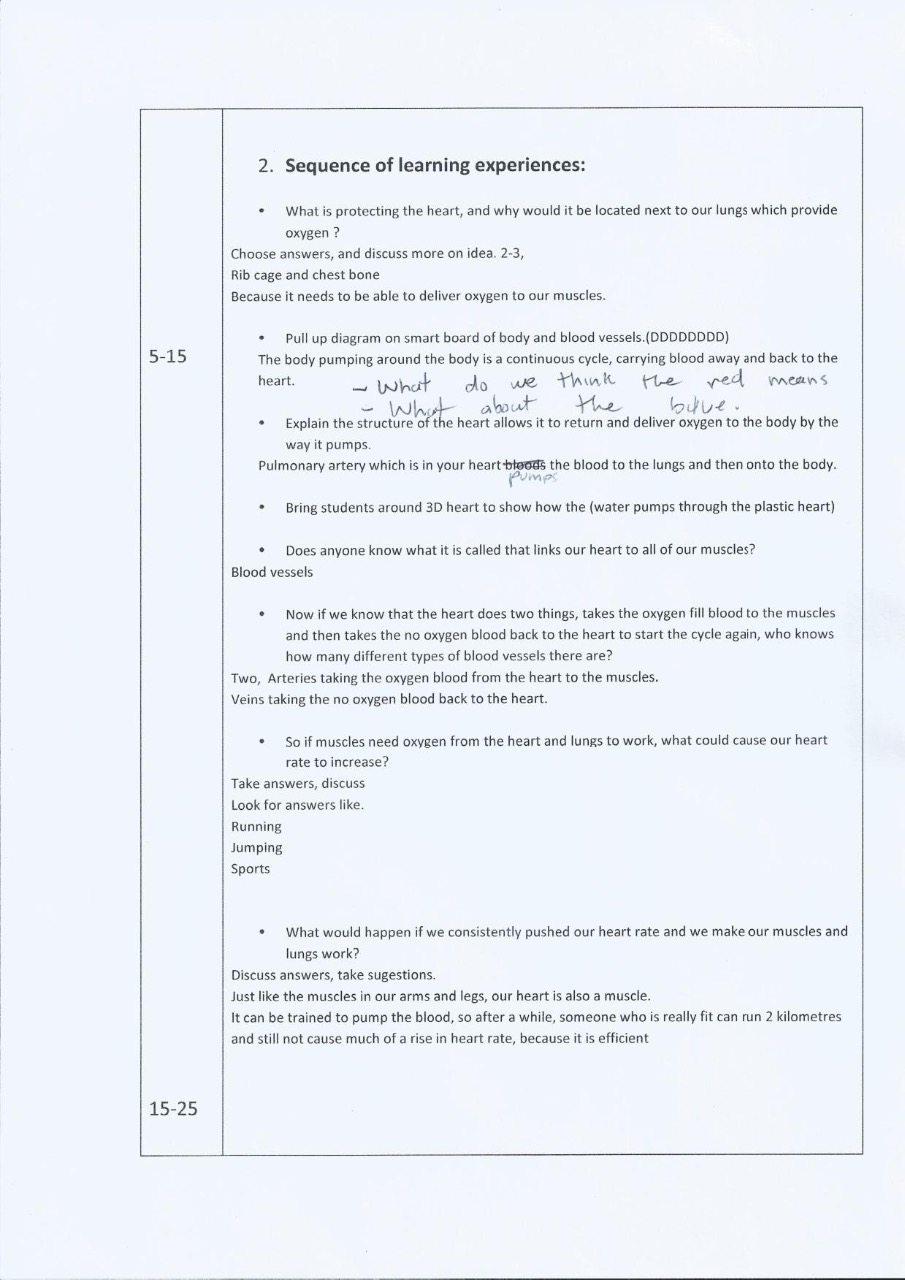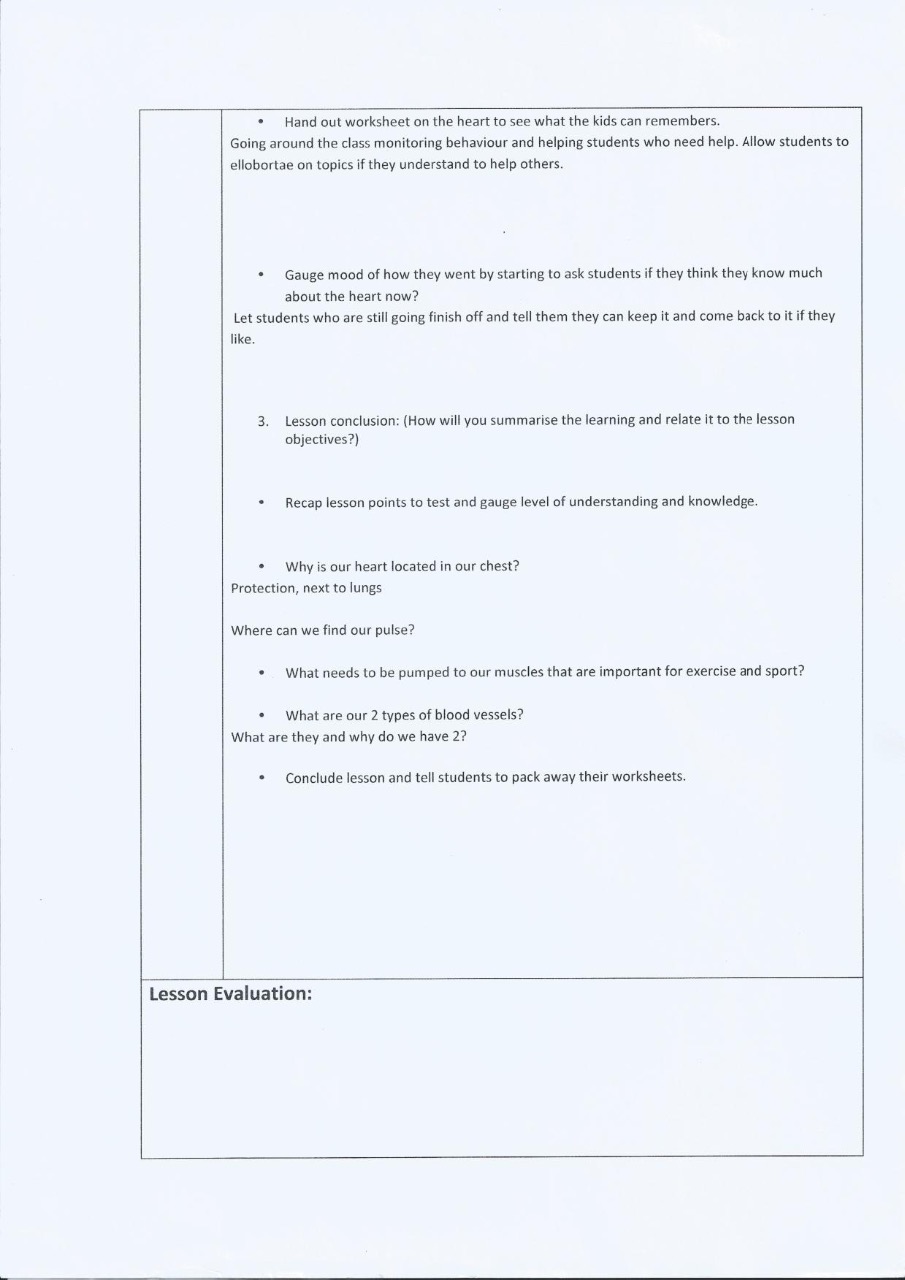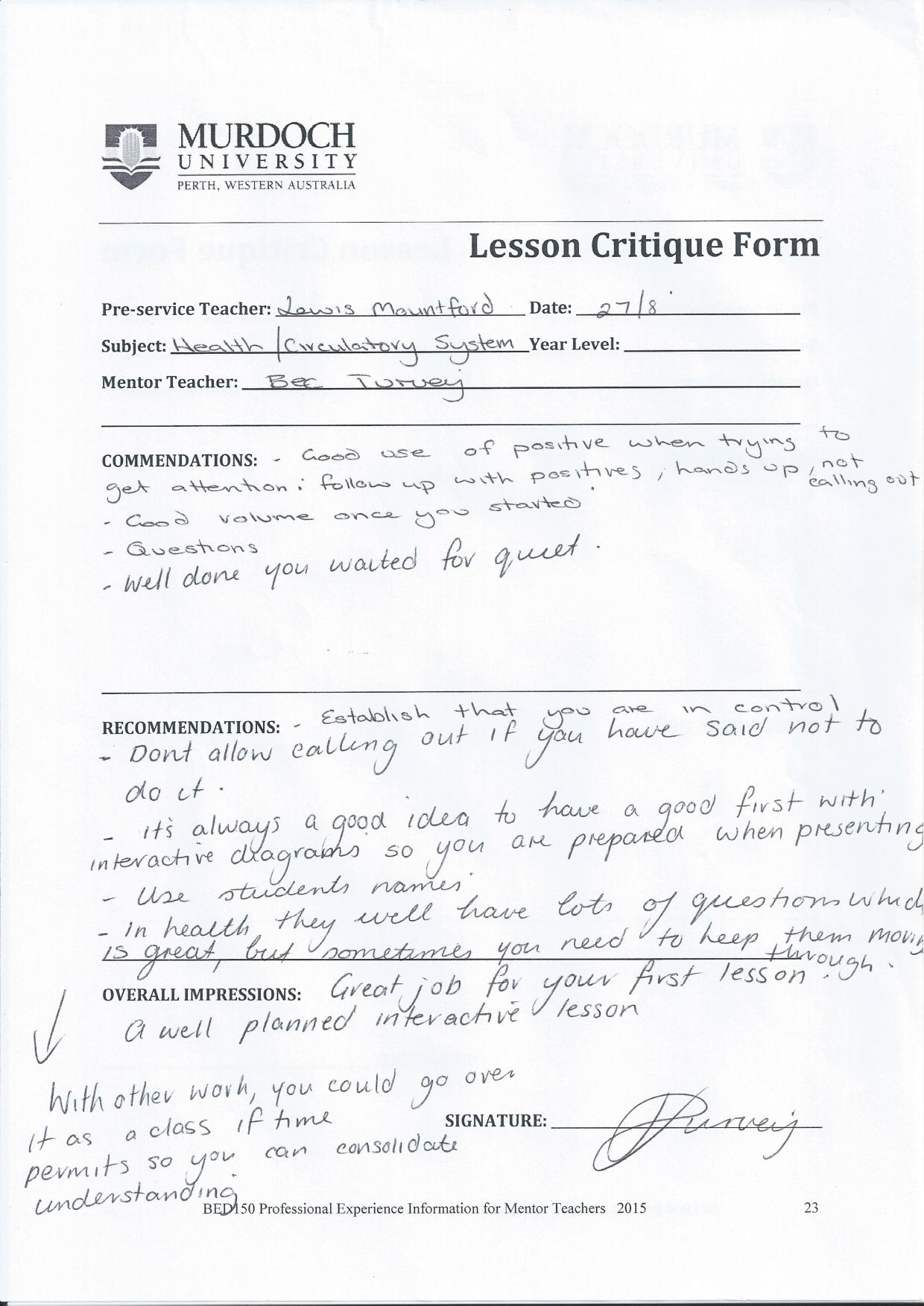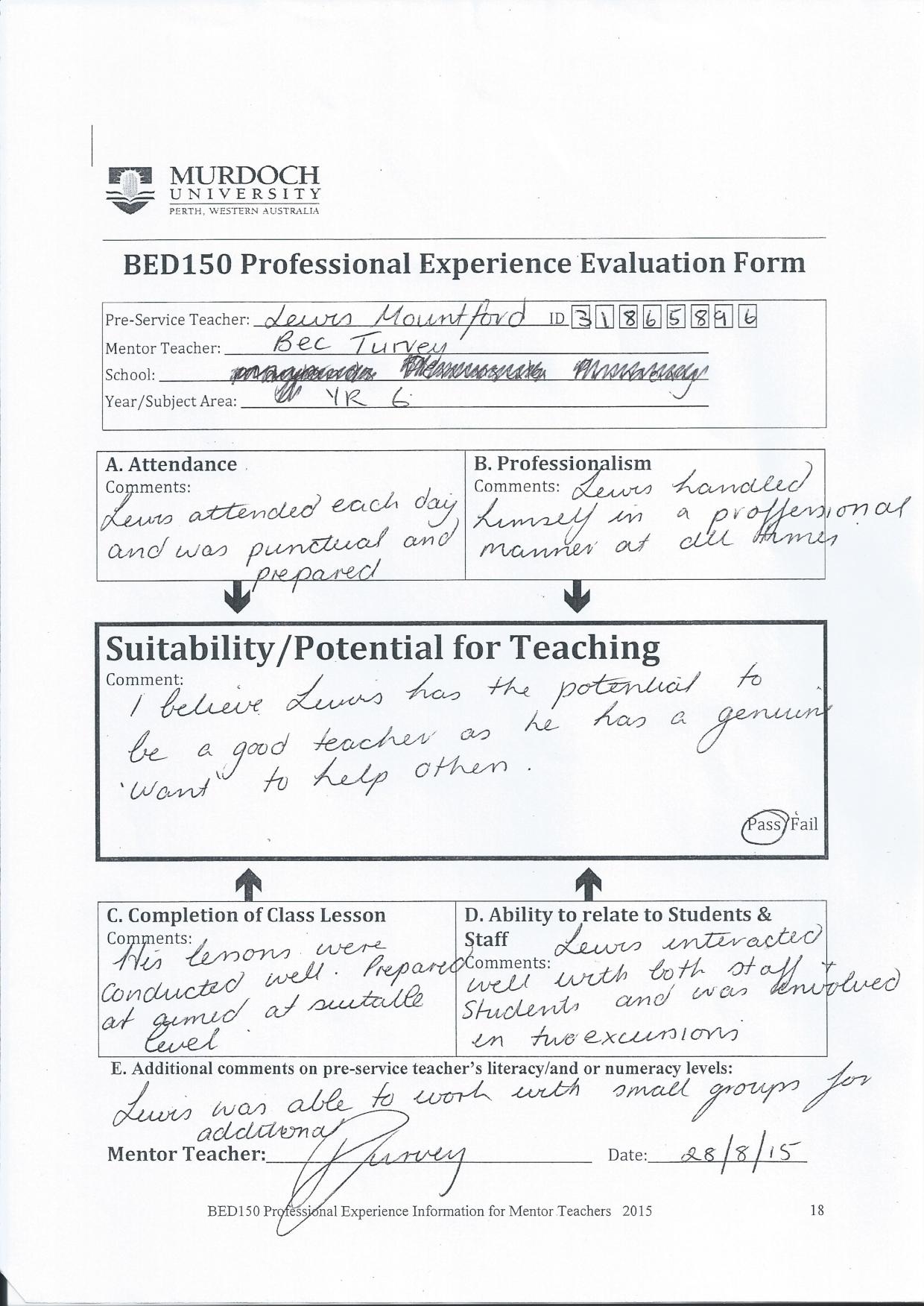Primary teaching experience
Lesson Plan
|
Day: M T W T F Date: 27/8/15 Time: __10am_Duration: 20 mins Year: 6
Learning Area: phys ed Topic: boot camp with team games |
|
|
Curriculum content description: Participate in physical activities designed to enhance fitness, and discuss the impact regular participation can have on health and wellbeing (ACPMP064)
|
|
|
Students’ prior knowledge and experience: · Have had prior weeks of boot camp. ·
|
|
|
Learning purpose: · To give the students a good workout · To show them different games, of how fitness can be fun |
|
|
Learning objectives: On completion of this lesson, students will be able to:
· That the heart is vital is supplying our body with energy and oxygen. · To understand that blood is in our whole body. · Understand that blood and the circulatory system heals cuts and viruses. · To be confident with terms to do with the circulatory system such as veins and arteries.
|
Evaluation: (Explain how you will know that lesson objective have been achieved / monitor student learning)
· Gain understanding of knowledge through questioning discussion and explained answers at end of the session. · Through answers on the worksheet which we will answer at the
|
|
Preparation and Resources: · 1 Cone. · Stop watch · |
|
|
Catering for diversity
- Each activity can be run at a fitness level the student is comfortable with, giving their effort, no matter how much it is, is the main goal in all activities
|
|
Timing:
5-20
|
Learning Experiences:
1. Introduction: (How will I engage the learners?)
WARM UP: partner stretching dynamic leg swings, forward, side, arm swings forward and backwards, one each way , run to post and back for general warm up.
2. Sequence of learning experiences:
Activity 1 : Guess the street number of the premises. Might have to give a number range. Every wrong answer 5 burpees, let them know if answer is higher or lower. Keep going until get the correct number.
Activity 2 : Partnering up. One person is squats or lunge while the other runs to the cone and back. As a pair they have to get 50. And keep count. Have 2 different levels. A running and walking cone to run too. To cater for different levels
Activity 3: Get two teams bridging in rows. they each take a turn to run from one end, to the other. One person at a time, whilst the other students and holding a bridge. the team must complete 2 cycles before they can finish.
Activity 4: Cool down and stretch.
|
|
Lesson Evaluation: Being a personal trainer for work for the last 3 years, I felt comfortable in my environment taking the year 6’s for a boot camp. For my first activity I had them all line up in two straight lines. I noticed straight away they were harder to control than adults, even just to stand in a straight line. From seeing this early on I switched on more and started to discipline any students who were doing the wrong thing, with 2 push-ups. After I set the level of standard, all the kids listened to me, and worked hard in my activities, which I was happy with. After adapting to having more control of the students, by watching them closer, I really enjoyed taking the kids through the boot camp.
|
|

Observation Sheet – Questioning
(Please complete this form for both primary and secondary professional experiences and place in your ePortfolio)
Graduate Standards - AITSL
Professional Knowledge: 1. Know students and how they learn
Professional Practice: 2. Plan and implement effective teaching and learning
Question Type
|
Do you feel your questions were clearly structured and readily understood by the students?
|
Structuring my questions in my main lesson was the biggest bump to overcome. I was teaching the circulatory system, so I had to find a logical order of how to explain things. I started with basic questions like, what does the heart do? And then discussed these and moved onto how or why it works. Whether all students understood my questions I don’t know, because I had the same 5 kids trying to answer more of my questions. |
|
Did you use a variety of question types?
|
Yes I did use a variety of question types, to try to get a board selection of different answers.
Comprehension questions: Why would we need 2 different types of blood vessels?
Recall questions: What function does the heart have?
Synthesise questions: Which way would de oxygenated blood flow? And why?
|
|
What balances was there between the various questions types?
|
Yes, through all my questions there was a good balance of question types. At the start of my lesson, when I started to introduce the heart and its function I used recall questions. Although as I moved through I used comprehension questions to get the kids to explain what they understood. |
|
Consider both why and when you made use of the different question types?
|
Recall questions where good at the start of the lesson to give them a basic understanding of the heart and how it works. I asked comprehension questions and synthesise questions later in my lesson, to get them to explain and show their understanding. Although the year 6’s could not recognise the different question types, it made sense to them to have them in this order. |
Distributing and Directing Questions
|
Did you recognise any pattern in the distribution of your questions amongst the students? Consider reasons for this pattern?
|
Yes I did notice a pattern of starting with basic and simple questions, and as I taught my points, I could move to more complex question, that required more of an explanation and understanding. This pattern was important because I couldn’t of started with, “which way does de oxygenated blood flow, and why?” when I hadn’t explained that one of the functions of the heart was to carry oxygen to the muscles.
|
|
How have you directed questions to the group?
|
To direct questions I would start by giving some basic information about the topic, and go on the ask a question about it, to see if anyone could help explain and elaborate, helping them where needed in their response to give the whole class a good understanding. |
|
Have you used “wait” time?
|
I didn’t have to stop and wait for any students to stop what they were doing. Through the class all students stayed on track, with just a small amount of talk between them during activities. |
|
Did you make eye contact with the group as you directed your questions?
|
Yes whilst asking my questions and talking on the subject, I tried to maintain eye contact with everyone in the room to try and keep everyone engaged. |
Reactions to Student’s Responses
|
How do you deal with correct responses? Do you qualify any praise given?
|
To deal with correct responses I would say thanks, and yes that is the best or right way to go about this, and elaborate on the topic if they have missed out any points, but to also give the other students more of the right idea for the solution. If the student did give me the correct answer, I would prompt them and allow them to explain further. I definitely didn’t give any extra praise, because I had the same kids answering most of the questions, so it would of felt as though I left the other students out of praise. I found with the primary school kids even the kids who weren’t answering the questions, would still seemed interested to listen and learn, where as in the high school, if the student did not answer the question, they were pay less attention to the class in general. |
|
How do you deal with incorrect responses? How do you deal with students who stumble and grope for an answer? |
For incorrect responses in the primary school, I would say “ not quite”, or “your on the right track”, and then continue to give a hint or clue for that student. If they still couldn’t get the answer, then I redirected the question back out the class give someone else a chance to answer. For students who would be close to an answer, but couldn’t quite grasp it, I would say, “good, that is correct, but”, and continue to explain what point they had missed. |
|
What use do you make of the student’s responses to develop the teaching point? Have you redirected any questions in order to add to an initial response?
|
Taking students answers and redirecting them to a related question to me was there the class was tricky. I would listen to a question and then want to link it to something that they hadn’t learnt yet, or that wasn’t in the correct sequence. By doing this is got me off my lesson plan track of questions, because I found myself skipping questions in my plan, because I had already explained a point that had come after that. |
|
Are you the only evaluator of the student’s answers?
|
All the students should be listening to other students answer along with me as the teacher, to learn from their classmate and to also try to understand the point further for themselves. Although as the teacher I was the only person to agree or disagree to the answers given. |
Overall Comments
Observation Sheet – Management
(Please complete this form for both primary and secondary professional experiences and place in your e portfolio)
Graduate Standards – AITSL
Professional Practice:
1. Create and maintain supportive and safe learning environments
2. Planning for Effective Management
|
Was your lesson plan effective for managing the class?
e.g. How did the students react to your lesson overall and to your planned activities?
Did anything unexpected happen?
Did you provide a variety of activities?
Were you satisfied with your timing, particularly for the end of the lesson?
Did you feel you were able to change things if needed?
|
Yes I did find my lesson plan effective for controlling the class, using it to refer back too. I used it to start of my questions, but after that I didn’t look at it much, as the questions flowed on from one another. I also found it was helpful to refer back to when I didn’t know what I hadn’t covered so far during the lesson.
I felt as though the students reacted great to my lesson as well as my two activities. Because I took my lesson on the Thursday, I had a chance to get to know the kids before hand, which I think helped me with my confidence but also who much they listened to me.
Going into my lesson, I expected to follow my lesson plan questions in order to stay on track, but I ended up asking a few questions out of turn, which made me come off my plan a little bit.
I had one worksheet for everyone to try, covering the points I covered din my lesson. I provided help to the kids who needed it, all the kids were able to get through the worksheet so I feel I did not need to provide another level. Once students had finished, I had a circulatory word sleuth for them to complete before the end of the day if they finished early.
Through my question phase I felt like I lost track of time. I had been discussing ideas and showing a diagram on the board and I had taken up half of my lesson time, when I realised I better leave them some time to actually complete the activity. The end of the lesson was good timing as about half the students had finished their word sleuth’s just as the end of class came around.
Yes I feel as though I could have changed things because I did feel in control the whole lesson. I feel as though I changed things too easily as I strayed off my lesson plan order once or twice.
|
|
Were you aware of classroom procedures and school disciplinary policy? How much did you know about your students?
How did your mentor teacher maintain a safe learning environment? What strategies did your observe your mentor teacher using to maintain this? |
Being a primary class I did not have many memories of classroom rules and games to keep students on track, so it was fun to come back to the classroom, and learn the policies the year 6 class had in place. They had a classroom shop that each student would get imaginary money added or deducted to their total, to buy presents at the end of the term, such as sports balls, or chocolate or lollies. Through the week I did not see the teacher deduct any points, but it was used as a way to make them clean their desks, or keep their work station tidy.
From the very first day I felt comfortable with my mentor teacher. She had a way of having a personal connection with each of her students, myself included, but also laid down the rules for her students to adhere to. The class had rules to follow, but I noticed that she didn’t have to constantly remind her students of what these were. Each student knew the boundary, and felt responsible to stay within it, to maintain the relationship and connect with their teacher. |
Maintaining a Positive Attitude in the Classroom
|
How did you demonstrate to the students that you valued them, and enjoyed learning?
e.g. Tone of voice, facial expression, sense of humour, introduction to students and topic. |
With primary kids, I had forgotten how excited they get over things that they do. I loved having this response of enthusiasm and I found that it made me pay attention to what the students were saying, and get on their same level of excitement I found giving the students my attention with my facial expressions and tone the easiest thing to do, as I felt a want to help them if they had brought a question to me.
|
|
Which aspects of your teaching style do you feel helped you maintain class attention?
e.g. Variety of activities, class or group discussion, pace of lesson, interest at class level. |
Key to giving my boot camp fitness session and my circulatory system class was the kids level of interest in both of the topics. During my circulatory system lesson, not many of the students had any knowledge in the subject, so I found they were generally interested to learn about the heart and the way its connected to our body.
|
|
Did the students know what was expected of them?
|
From my mentor’s teachers standard of attention and learning, I found I had no problems with my class. All my students listened well, and even the students who would have had trouble grasping all of the concepts, continued to listen and pay interest. As I expected most of my questions were answers by the same 4-5 students, who had more knowledge in the area from past learning.
|
|
Were you able to redirect energies of attention seeking students? Did the students have enough to do? |
I had one boy who would continue to raise his hands for questions even whilst I was talking. His questions where mostly off topic and I found that this was hard to bring back to the topic of discussion. I end up saying, “that is a good question, but not related so much to what we are talking about”. |
Dealing with Minor Misbehaviour
|
Were you aware of what was happening in all parts of the classroom? Did you know what each student was doing? |
All students would work quietly on their work or being chatting in small groups if they had finished their work. The teacher allowed students to talk if it as long as it did not reach noisy levels. I felt you could tell how was going their work, and who was doing a little, and then chatting, but at all times I knew what most students were doing.
|
|
Did you take any action when you observed poor behaviour? Why? Why not? |
There was a time when I did observe bad behaviour. One student was swearing whilst walking to an excursion. I told hi, that it was not the language he should use at all, and if he continued ill tell the teacher what he was doing. This put a stop to his language at the time, whether he will change it in the long run, I was able to put a stop to it at the time.
|
|
Did you use non-verbal cues? e.g. Contact, pause, gesture, movement toward student/s concerned.
|
Non verbal cues was again what I found most effective to let a student know they were doing the wrong thing. Because my primary class had a good level of behaviour management, without the teacher having to constantly tell students what to do, I found it was easy to let students know they were doing the wrong thing. The other behaviour management strategies I found useful was to use the students name to get their attention and to think, and stop, and understand that I’ve used their name, they must be doing something wrong or in the wrong way.
|
Overall Comments
Schools as text – looking at the whole school
|
Describe the school in terms of its demographics, appearance and resources (be general here and do not name the school).
|
· Within a largely populated area (apartments) · Largely diverse culture in the community and within the school · Large sports fields · Music room · Assembly area ·
|
|
What were the roles and responsibilities of the teaching staff you observed?
|
· Evacuation coordinator · Teacher · Mentor
|
|
After discussion with your mentor teacher describe how policies and processes of government, administration and schools have an affect on the work of the teacher
|
In a chat with my mentor teacher whilst on lunch duty, I asked her how she covers everything in her curriculum and still has time for activities that were more fun and interactive still. She said that she uses assignments to cover multiple parts of the curriculum for the students to demonstrate skills, that the government requires her to test and observe. |
|
What did you observe non-teaching staff doing to support teaching and learning in the school?
|
In terms of teacher assistants and lesson preparers, this school did not have any that I saw in the 5/6 level I was placed. All surrounding teachers did work together to achieve outcomes that they all lent a hand to organise. The week I was in the primary school, there was athletics training happening. This required 4 teachers to organise what time they could let this happen, and also which teacher would take which game. |
Students
|
You will have observed the diverse nature of your classes. How was this diversity supported?
|
The year 6 class that I was apart of was very diverse in terms of level of achievement in fundamental areas such as maths and English. In the class you had students completing math problems that required both multiplication and addition and subtraction, and then, there was the level of not understanding the principle of multiplication, even with the two times table. When teaching maths to a whole class, this can present a problem when teaching for two different levels of understanding. To cater for this the students had different level math books which they would complete. Often the teacher would spend her time during maths, helping the group of students who were struggling. While I was there I got to help and take this group of students through an activity about reading time. |
Function of Schools
|
Did you observe the connection of your schools with the broader community? How did this happen?
|
Being a primary school I feel like it was harder to stay connected to the community, because you can offer less services such as making coffee or running a car wash etc. One way the school was connected with the community was the environmental competition my class was participating in. Each students had to take 3 photos of the natural environment, and these were being sent into chevron, who were sponsoring a competition for the best photo. By entering this, the school was showing the public, and the community about there commitment to such isssues. |
|
What do you think the function of school is?
|
I think the function of primary school is to prepare these kids of what becoming an adult holds for them, and what responsibilities need to be self managed to achieve well through high school and into their adult hood. These responsibilities such as time management, organisation, and fair decision making. |
